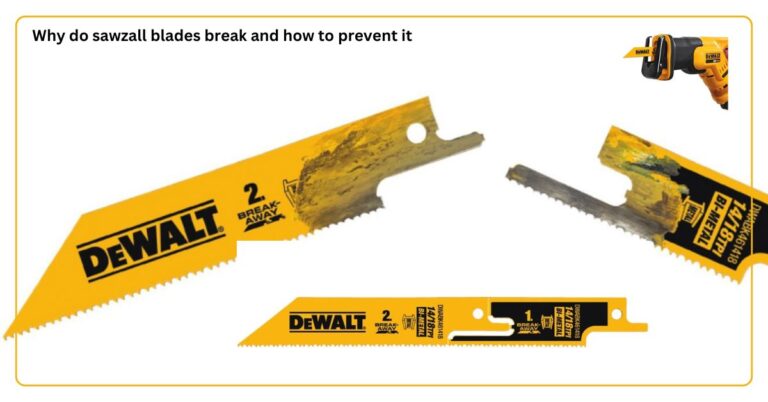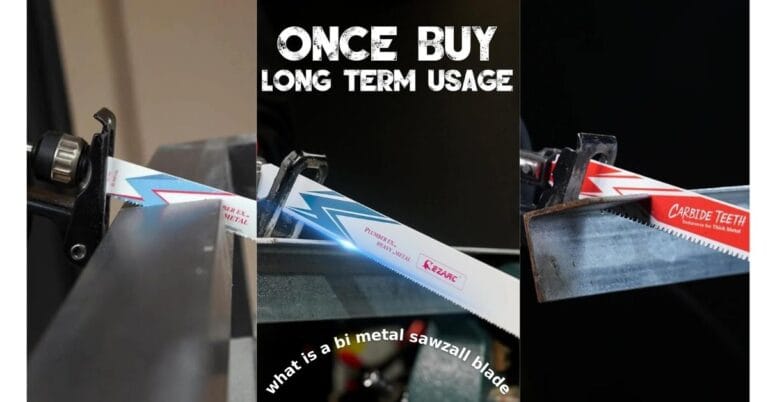When it comes to getting clean, precise cuts with your saw, the blade you choose makes all the difference. Whether you’re tackling wood, metal, or tile, using the right saw blade doesn’t just improve performance; it saves time, boosts efficiency, and extends the life of your tools. At BestSawzallBlades, we know that even the most powerful saws are only as good as the blade they’re paired with. In this guide, we’ll break down why blade choice matters, the different types available, and how to use and maintain them correctly to get the best results from every cut.
The Real Cost of Using the Wrong Blade
Using the wrong saw blade may seem like a small mistake, but the consequences can be serious and expensive. According to the National Library of Medicine, over 1.38 million injuries related to saws required emergency room visits between 2003 and 2022. Many of these accidents are preventable and often linked to poor blade selection, dull edges, or improper use.
A mismatched or low-quality blade is more likely to overheat, wobble, or even become warped, putting both the operator and the material at risk. These issues can lead to erratic cutting behavior, increased friction, and uncontrolled movement, factors that compromise both precision and safety.
What’s more, using an incompatible blade often results in wasted time spent fixing mistakes, replacing damaged tools, or restarting entire jobs. In the long run, this adds up to lost productivity and higher costs, something no professional or DIYer can afford.
Types of Saw Blades: Which One Do You Need?
With so many materials to cut wood, tile, metal, and stone, there’s no one-size-fits-all saw blade. Choosing the right types of saw blades ensures better results, reduced wear, and increased safety. One of the most reliable and durable options is the diamond blade, available in several configurations to match your specific application. Trusted brands offer high-quality diamond blades built for both precision and longevity.
Dry Diamond Blades
Designed for cutting without water, dry diamond blades are perfect for job sites where wet cutting isn’t practical. Their segmented or turbo rims help reduce heat buildup and allow for aggressive cuts in concrete, brick, or tile, though they tend to produce more dust.
Wet Diamond Blades
Used with water to reduce friction and dust, wet diamond blades are ideal for hard materials like granite and porcelain. These blades stay cooler during use and provide smoother, cleaner cuts, especially when precision is a priority.
“Diamond blades are one of the most durable options, especially if you’ve ever wondered, ‘can Sawzall blades cut through concrete and stone?’ While Sawzall blades can handle certain masonry tasks, diamond blades are the go-to choice for precision and longevity on tough materials like brick, tile, and stone.”
Cutting + Grinding Combo Blades
These versatile blades allow you to cut and grind using the same tool. They’re perfect for tasks that require edge smoothing or surface prep, making them a great choice for flooring, tiling, or stonework.
How to Choose the Right Blade for Your Saw
The secret to choosing the right blade lies in matching it to your project and equipment. Use this quick checklist:
- Material Being Cut: Choose a blade made specifically for the material, wood, metal, tile, or stone. Another key factor is TPI (teeth per inch). If you’ve ever wondered, ‘What does TPI mean on a Sawzall blade, and why does it matter?’, it directly affects cut speed and finish. Higher TPI is better for smoother, slower cuts on metal, while lower TPI handles fast, aggressive wood cutting.”
- Blade Compatibility: Check the blade arbor size and diameter to ensure a proper fit with your saw. Many beginners ask, ‘Are Sawzall blades universal or interchangeable?’ The answer is yes to an extent; most Sawzall blades fit standard reciprocating saws, but arbor size, shank design, and blade type still matter for safe, effective cutting.”
- RPM Rating: Make sure the blade can handle your saw’s speed. A mismatch can lead to overheating or failure.
- Segmented or Turbo Rim: Choose based on your need for speed (segmented) or smoothness (turbo).
- Blade Quality & Brand: Invest in a high-quality blade from trusted names to avoid performance issues and premature wear.
Using Saw Blades the Right Way: Expert Tips
Knowing how to use saw blades correctly keeps you safe and ensures better results. Let’s look at best practices before, during, and after cutting:
Before You Start
- Inspect the Blade: Look for cracks, dull edges, or missing segments.
- Wear Proper PPE: Always use safety goggles, gloves, hearing protection, and a dust mask.
- Ensure Compatibility: Confirm the blade fits your saw and meets the proper RPM rating.
- Set Up Water Flow: For wet diamond blades, ensure water is available and flowing.
While Cutting
- Apply Steady Pressure: Don’t force the blade; let it cut at its own pace.
- Maintain Correct Speed: Too fast = overheating. Too slow = friction buildup.
- Use Water Cooling: Keeps the blade from burning out and ensures clean cuts.
After Cutting
- Let It Cool: Especially after dry cutting, allow the blade to cool naturally.
- Clean the Blade: Remove debris and buildup to maintain sharpness.
- Store Properly: Hang or lay flat in a dry place to avoid bending or corrosion.
Blade Maintenance: Keep Your Edges Sharp
Proper blade maintenance is the key to longevity and cost savings. Here’s how to maintain saw blades for peak performance:
- Blade Cleaning: After each use, clean the blade using water or a soft brush to remove buildup.
- Blade Cooling: Don’t handle blades immediately after cutting. Let them cool first.
- Blade Storage: Store in a dry, flat area to prevent moisture damage or warping.
- Break-In Technique: New blades should be eased in with light pressure for the first few cuts to expose fresh cutting surfaces.
When to Replace a Blade
- Visual Damage: Cracks, rust, or worn-down segments.
- Cutting Performance Drops: Burn marks, rough edges, or higher resistance.
- Blade Wobble: Indicates a warped blade and poses serious safety risks.
Fixing Common Saw Blade Problems
Blades wear down over time, but most problems are preventable with simple solutions.
Overheating
- Cause: Cutting too fast, dry cutting hard material, or blade mismatch.
- Fix: Slow your speed and use wet blades for harder materials.
Blade Wobble
- Cause: Loose flange, warped blade, wrong arbor size.
- Fix: Tighten the arbor, replace damaged blades, and ensure a correct fit.
Fast Wear
- Cause: Cutting incompatible materials, too much pressure, and poor maintenance.
- Fix: Match the blade to the material, apply steady pressure, and clean after use.
Users often wonder, ‘Why do Sawzall blades break, and how can we prevent it?’ The most common causes include applying too much pressure, cutting with the wrong TPI, or hitting hidden nails. Choosing the right blade and maintaining steady technique greatly reduces breakage.”
Blade Sharpening Tools That Save Time and Money
Instead of replacing dull blades, consider sharpening them. It’s a smart long-term investment:
- Saw Blade Sharpener: Great for home users and contractors looking to revive standard blades.
- Circular Saw Sharpener: A Precision tool made specifically for circular blades, ideal for woodworkers.
- CNC Saw Blade Sharpening Machine: A professional-grade tool that offers automated, consistent sharpening with custom angles.
- Professional Sharpening Services: Affordable and ideal for specialized blades like diamond or carbide-tipped options.
Sharpening isn’t just about saving money; it’s about preserving cutting performance and keeping your workflow smooth.
Conclusion: Smarter Blade Choices, Better Results
The right blade doesn’t just make a better cut, it makes every part of your work more efficient, from start to finish. With better cutting performance, longer blade life, reduced waste, and improved control, you’ll finish projects faster, safer, and with cleaner results. Whether you’re replacing an old blade, buying a new one, or maintaining your current tools, making smart blade choices is what separates amateurs from experts.
Ready to upgrade your cutting game?
Explore top-rated saw blades and sharpeners at BestSawzallBlades, your trusted source for expert cutting solutions.
Frequently Asked Questions
What happens if I use the wrong saw blade?
Using the wrong blade can lead to poor cuts, blade damage, overheating, and even safety hazards like kickbacks or wobbling. It can also reduce your tool’s lifespan and waste materials.
How do I know which saw blade is right for my project?
Match the blade to the material you’re cutting (wood, tile, metal, etc.) and ensure it’s compatible with your saw’s arbor size and RPM. Check if a dry or wet blade is needed.
What are the benefits of using a high-quality saw blade?
Cleaner cuts, faster work, longer blade life, and improved safety. High-quality blades also reduce waste and minimize strain on your saw motor.
How often should I replace my saw blade?
Replace it when you notice dullness, warping, wobbling, or a drop in cutting performance. Visual cracks or broken segments are signs that it’s time to change it.
Can I sharpen my saw blades instead of replacing them?
Yes! Using a saw blade sharpener or professional sharpening service can restore blade performance and extend its life. It’s often more cost-effective than buying new ones.
How do I maintain my saw blades for long-lasting use?
Clean them after use, allow them to cool properly, and store them flat or hung in a dry space. Use a break-in technique for new blades and avoid cutting materials they’re not designed for.






